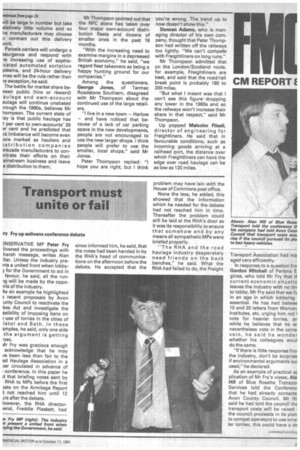roo many depots spoil distribution broth
Page 20

Page 21

If you've noticed an error in this article please click here to report it so we can fix it.
ill the large multiples dictate future pattern? David Wilcox reports ETER THOMPSON, deputy lairman and chief executive of
e National Freight Company, d a little crystal ball gazing and Id delegates what lies ahead ,r the distribution industry in le 1980s.
The subject of finite energy reources in the future was rushed aside by Mr Thompson ecause, he said, we are finding ew reserves of energy at least 3 fast as we can use the existing nes.
Although diesel has escalated 1 price, so has every other form
f energy and so electric batteryowered vehicles are not likely ) make any real impact in the 980s.
Mr Thompson also saw little hence of the railways grabbing larger slice of the freight maret. Although a Freightliner train appears more efficient than the lorry, when the real costs of transhipment, etc, are included, it is not significantly more efficient. So a road-based distribution pattern will still be the order of the day in the 1980s, concluded Peter Thompson.
Some manufacturers' distribu
tion systems have not fully adapted to this country's new motorway network, he argued, and tend to still have too many depots. In the 1950s about 15-25 regional distribution depots were considered essential for nationwide, distribution; by the 1970s it was felt that five or six depots were adequate.
But Mr Thompson believes two or three regional depots will be sufficient when the roundLondon M25 is completed. He doubted if we would ever opt for a single large public transhipment centre such as Garonor on the outskirts of Paris, because in Britain large depots are rather prone to industrial relations problems. The only factor that could change this was if widescale lorry bans in High Streets became common.
In recent years, the growth of the large multiple retailer and the demise of the smaller shops has been a dominant trend, he said. In 1971 large multiples had 45 per cent of the retail turnover; by 1979 this share had rise 54 per cent, and this was at expense of the small shops.
It is therefore these I multiples that now dictate pattern of distribution, he They generally demand a dedicated distribution servic that they can maximise SE space and minimise St holding in their valuable Street premises.
Mr Thompson expects trend of dedicated distributi, continue even further: "Th tailer will be the king and command the distribu chain."
Following on from this then predicted a rosy futu the 1980s for the general pa carrier, reasoning that the pick up the delivery work t remaining small retailers. 1
vill be large in number but take elatively little volume and so he manufacturers may choose 3 contract out this delivery vork.
Parcels carriers will undergo a asurgence and respond with le increasing use of sophiscated automated sortation ystems, and 24-hour delivery mes will be the rule rather than le exception, he said.
The battle for market share beveen public (hire or reward) aulage and own-account aulage will continue unabated 'rough the 1980s, believes Mr hompson. The current state of lay is that public haulage has 1 per cent to own-accounts' 39 ar cent and he predicted that is imbalance will become even lore marked as hauliers and istribution companies arsuade manufacturers to coneitrate their efforts on their ainstream business and leave e distribution to them. Mr Thompson pointed out that the NFC alone has taken over four major own-account distribution fleets and dozens of smaller ones in the past 18 months.
"With the increasing need to examine margins in a depressed British economy," he said, "we regard fleet takeovers as being a happy hunting ground for our companies."
Among the questioners, George Jones, of Tarmac Roadstone Southern, disagreed with Mr Thompson about the continued use of the large retailers.
"I live in a new town — Harlow — and have noticed that because of a lack of car parking space in the new developments, people are not encouraged to use the new larger shops. I think people will prefer to use the smaller, local shops," said Mr Jones.
Peter Thompson replied: "I hope you are right, but I think you're wrong. The trend up to now doesn't show this."
Duncan Adams, who is managing director of his own company, thought that Peter Thompson had written off the railways too lightly. "We can't compete with Freightliners on long runs."
Mr Thompson admitted that on the London/Scotland route, for example, Freightliners are best, and said that the road/rail break point is probably 180 to 200 miles.
"But what I meant was that I can't see this figure dropping any lower in the 1980s and so the railways won't increase their share in that respect," said Mr Thompson.
Up popped Malcolm Filsell, director of engineering for Freightliners. He said that in favourable conditions, such as incoming goods arriving at a railhead port, the distance over which Freightliners can have the edge over road haulage can be as low as 120 miles.








































